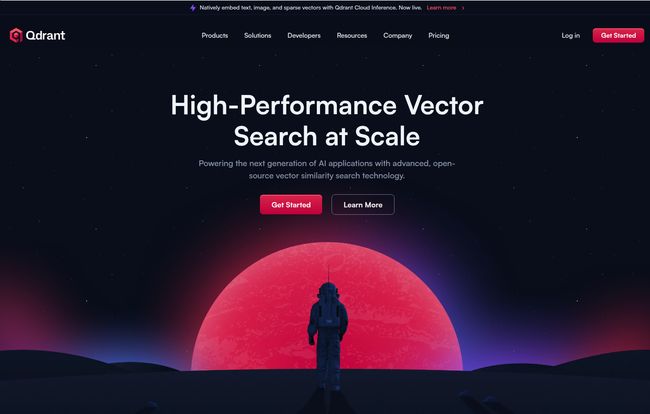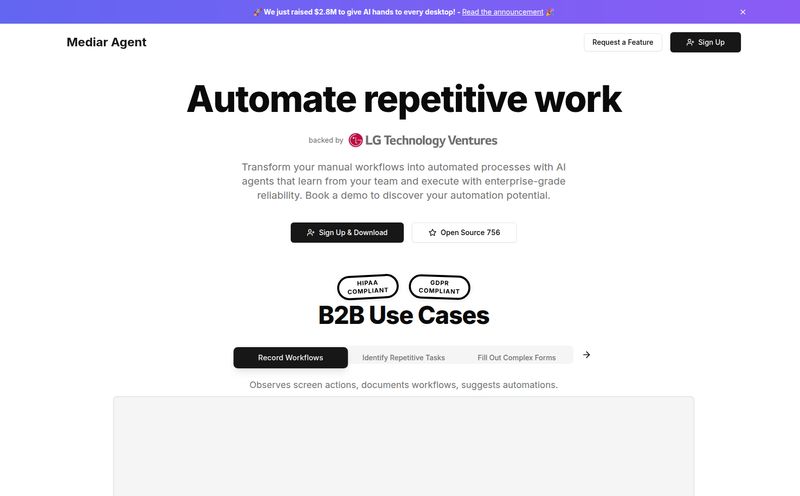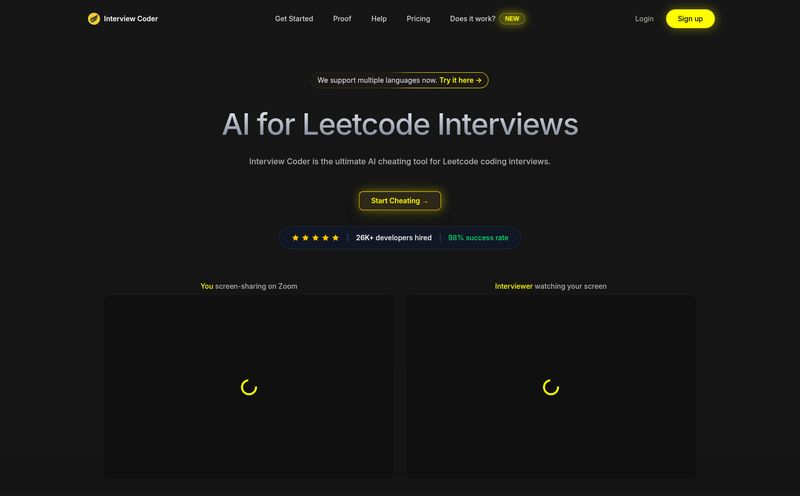The AI world is in the middle of a gold rush, and everyone's talking about the shiny new LLMs. It’s all ChatGPT this, generative AI that. But as someone who's been in the trenches of traffic generation and tech trends for years, I know the real magic—and the real headaches—often happen in the plumbing. The unseen infrastructure that makes all the cool stuff possible.
We're generating and using vector embeddings for everything these days. They're the secret sauce that lets us search by meaning and not just keywords. But where do you store all these high-dimensional vectors? Your trusty old PostgreSQL is going to choke. You need a specialized tool. A vector database. And that's why I've been keeping a very close eye on Qdrant.
It’s been making waves, and for good reason. It’s not just another player in a crowded field; it feels like it was built from the ground up to solve the very specific, very modern problems AI developers are facing right now.

Visit Qdrant
So, What Exactly is Qdrant?
At its heart, Qdrant (pronounced 'quadrant') is an open-source vector database and vector search engine. Imagine you have a massive library, but instead of organizing books alphabetically, you organize them by the ideas and concepts they contain. A book about space exploration would sit next to a sci-fi novel, not a book about spelling. That, in a nutshell, is what Qdrant does for your data.
It takes your vectors—those numerical representations of text, images, or audio—and allows you to find the most similar items with mind-boggling speed. This is the core technology behind things like recommendation engines, semantic search, and the increasingly popular Retrieval-Augmented Generation (RAG) systems that give LLMs long-term memory. But Qdrant isn't just a search index; it's a full-blown database, built to be reliable, scalable, and surprisingly convenient to work with.
Why I'm Genuinely Excited About Qdrant (The Core Features)
I see a lot of tools cross my desk. Most are just iterations of something else. Qdrant feels different. Here's what stands out to me.
Built on Rust for Speed and Sanity
Okay, I have to nerd out for a moment. Qdrant is written in Rust. Why does this matter? For a long time, if you wanted performance, you used C++. But C++ can be... let's just say, a source of many late-night-debugging-sessions fueled by stale coffee. Rust gives you that same bare-metal performence but with a huge emphasis on memory safety. For a database, which needs to be rock-solid and predictable, this is a massive advantage. It's like having the engine of a Formula 1 car but with the safety features of a Volvo. You get incredible speed without the constant fear that everything might suddenly explode.
Scaling That Doesn't Give You a Heart Attack
Starting a project is one thing. Scaling it to handle thousands or millions of users is another. Qdrant is built to be cloud-native. It's designed to scale horizontally, which means as your needs grow, you can just add more machines to the cluster. It supports high-availability and replication, so your application doesn't go down if a single server has a bad day. For anyone building a commercial-grade AI solution, these aren't nice-to-haves; they're absolute necessities.
More Than Just a Search Box
This is a big one. Some vector search solutions are a bit of a one-trick pony. They find similar vectors, and that's it. Qdrant allows you to store metadata (they call it a 'payload') along with your vectors. More importantly, you can filter your search based on that payload before the vector search even happens. Want to find products similar to a 'blue shirt' but only for 'men' and 'under $50'? Qdrant does that efficiently. This combination of traditional filtering with cutting-edge vector search is incredibly powerful and something I feel is often overlooked.
The Real-World Magic: Qdrant Use Cases
Okay, enough about the technical bits. Where does the rubber meet the road? The site lists a few key use cases, and they map perfectly to the biggest trends in AI right now.
- Retrieval-Augmented Generation (RAG): This is the hottest ticket in town. You hook an LLM up to a database like Qdrant to give it access to your private, up-to-date information. Qdrant acts as the long-term memory, feeding the model relevant context so it can answer questions about your specific documents or data.
- Recommendation Systems: Think Netflix, Amazon, or Spotify. 'Users who liked X also liked Y.' This is classic similarity search. Qdrant can power these systems to provide hyper-personalized recommendations in real-time.
- AI Agents: As AI agents become more autonomous, they'll need a persistent, searchable memory to learn and make decisions. A high-performance vector database is the perfect foundation for that memory.
"We chose Qdrant due to its high performance and the fact that it is open source... We're seeing better relevance than we were getting with our previous ElasticSearch and pgvector setup." - John Miller, Senior Data Scientist, HubSpot
When a company like HubSpot gives a thumbs-up, you tend to listen. It validates the idea that this is a tool built for serious work.
Let's Talk Money: Qdrant's Pricing Model
Pricing can make or break a tool for me. I love that Qdrant has a clear, transparent model that caters to everyone from a solo dev tinkering on a weekend to a massive enterprise. I've broken it down here:
| Plan | Starting Price | Best For |
|---|---|---|
| Managed Cloud | $0 | Developers and small teams starting out. The free 1GB cluster with no credit card required is a fantastic way to get your feet wet. |
| Hybrid Cloud | $0.014 / hour | Teams that want to run Qdrant on their own cloud infrastructure (AWS, GCP, etc.) but still want the benefits of a managed service. |
| Private Cloud | Custom | Large enterprises with strict security, compliance, or on-premise requirements. |
That free tier is not a gimmick. It’s genuinely useful for building proofs-of-concept and small applications. I have a huge amount of respect for companies that do this; it shows confidence in their product.
The Good, The Bad, and The Code
No tool is perfect, right? From my analysis and experience, here's the breakdown. The biggest advantage is that it's open-source and written in Rust, which means you're getting top-tier reliability and performance. The scalability is cloud-native, and it's built to integrate with all the popular frameworks you're probably already using. Thousands of companies, including big names like Microsoft and Bayer, are already using it which is great social proof.
On the flip side, this is a powerful, professional-grade tool. If you're managing it yourself (not using the managed cloud), it may require some technical expertise to deploy and manage correctly. This isn't a simple plugin you just switch on. You need to know your way around things like Docker and cloud infrastructure. Also, the enterprise-level pricing is only available on request, which is pretty standard but something to be aware of.
Frequently Asked Questions about Qdrant
- 1. What is Qdrant used for?
- Qdrant is primarily used for building AI applications that require fast and scalable similarity search. This includes things like semantic search engines, RAG systems for LLMs, recommendation engines, and even image or audio matching.
- 2. Is Qdrant really free?
- Yes! It's an open-source project, so you can host it yourself for free. Additionally, their Managed Cloud offering has a generous free tier that includes a 1GB cluster with no credit card required, which is perfect for development and small projects.
- 3. Why is being written in Rust a big deal for a vector database?
- Rust provides performance comparable to C++ but with strong safety guarantees, especially around memory management. For a database that needs to be fast, stable, and handle lots of concurrent requests, this combination is ideal. It leads to a more reliable and efficient system.
- 4. Can Qdrant handle more than just vector search?
- Absolutely. One of its key strengths is the ability to store rich JSON payloads with vectors and use advanced filtering on that data. You can pre-filter results based on specific criteria (like price, category, date) before performing the vector search, making queries much more efficient and powerful.
- 5. How easy is it to get started with Qdrant?
- It's surprisingly straightforward, especially for developers. You can pull a Docker image and have a local instance running with a single command. The documentation is clear, and the API is well-designed, with client libraries for popular languages like Python.
Final Thoughts: Is Qdrant the Right Choice?
After digging in, I'm pretty impressed. Qdrant strikes a fantastic balance between raw power and developer convenience. It's not trying to be a one-size-fits-all database; it knows exactly what it is—a high-performance engine for the AI era—and it excels at it.
If you're a developer or a company building anything that relies on understanding the meaning of your data, you owe it to yourself to check Qdrant out. The open-source nature, the stellar performance from its Rust core, and the genuinely useful free tier make it a very compelling option in a space that's only going to get more important.
This isn't just another tool. It feels like a fundamental piece of the modern AI stack.



